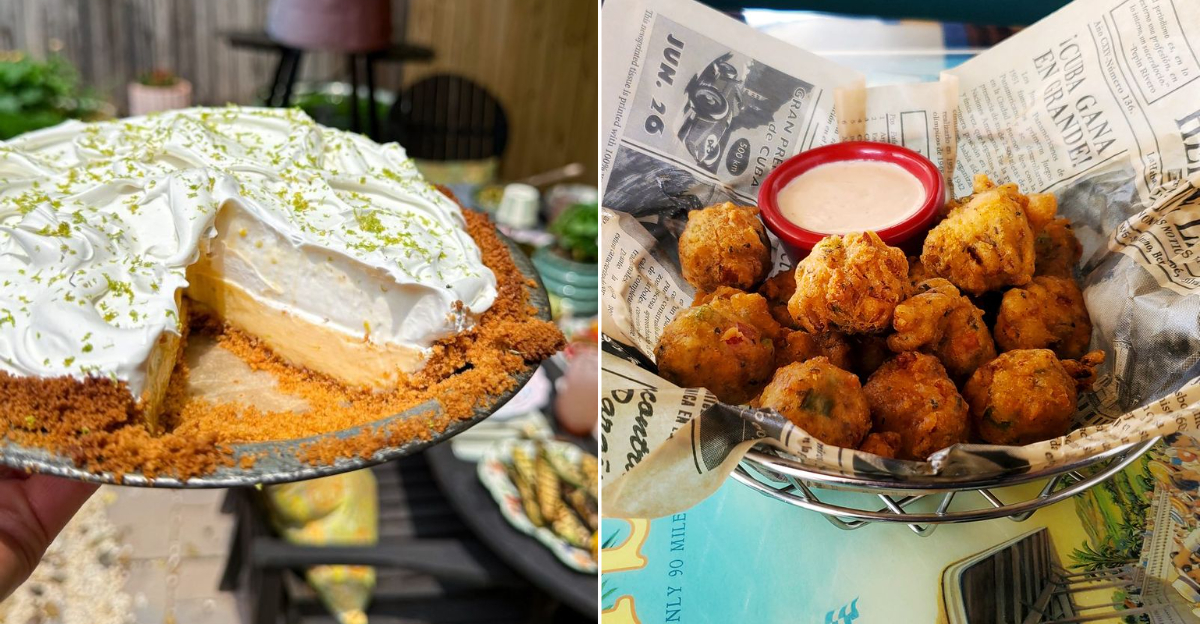9 Florida Food Traditions That Sound Wrong Until You Dig In

Florida’s food scene is as wild as its swamps and beaches.
Growing up in the Sunshine State, I’ve watched tourists scrunch their noses at our local delicacies before becoming devoted fans.
These unique eats reflect our melting pot of cultures – from Caribbean influences to Southern traditions and fresh seafood abundance.
Ready for a tasty tour of Florida’s most eyebrow-raising culinary treasures?
1. Gator Tail: The Swamp’s Surprising Delicacy
The first time my uncle served me fried gator tail at a family cookout, I nearly ran for the hills! Who eats alligators? Floridians do, and with good reason.
This white meat tastes like a magical cross between chicken and fish with a firm texture that’s perfect for frying. Most restaurants serve it battered and deep-fried with a spicy remoulade sauce that complements its mild flavor.
Gator hunting is strictly regulated, making this a sustainable choice when properly sourced. The tail meat is low in fat and high in protein – practically a health food if you ignore the breading! Locals claim it cures everything from the common cold to a broken heart, though I can only personally vouch for its ability to cure curiosity.
2. Cuban Sandwiches: Tampa Vs. Miami’s Delicious Rivalry
My grandmother would disown me if I didn’t declare Tampa’s version superior, but I’ll try to stay neutral in Florida’s great sandwich war. The Cuban sandwich – pressed perfection layered with roast pork, ham, Swiss cheese, pickles, and mustard – sparks fierce debates across the state.
Tampa’s version includes salami, reflecting the Italian immigrants who worked alongside Cubans in Ybor City’s cigar factories. Miami purists consider this addition sacrilege, insisting on a salami-free experience.
The magic happens when the sandwich gets pressed in a plancha, melting the cheese and creating that signature crispy exterior. Finding an authentic Cuban requires seeking out family-run cafés where the counter staff might scold you for requesting mayo – a cardinal sin that’ll immediately identify you as a tourist.
3. Swamp Cabbage: The State Tree In Your Soup Bowl
Harvesting Florida’s state tree for dinner sounds like environmental crime, but swamp cabbage – the tender heart of the sabal palm – represents old Florida cuisine at its finest. I discovered this delicacy at a backwoods festival where an elderly gentleman was cooking it in a massive cast-iron pot.
The pale, crunchy hearts get simmered with salt pork until meltingly tender. The flavor? Subtly sweet with an artichoke-like quality that pairs beautifully with the smokiness from the pork.
Cracker cowboys have harvested this survival food for generations, though today’s conservation laws limit collection to private lands or with special permits. Modern restaurants sometimes fancy it up as “hearts of palm,” but true Floridians prefer it simply prepared with minimal ingredients, allowing the unique flavor to shine through in soups, stews, or fritters.
4. Smoked Mullet: The Fish That Divides Floridians
Mullet – the fish so controversial it inspired bumper stickers reading “Eat Mullet, It’s Brain Food!” My grandfather would spend hours tending his smoker filled with these oily fish, creating neighborhood-wide aromas that either attracted hungry friends or sent them fleeing.
This humble fish splits opinions faster than a fisherman can cast a net. With dark, oily meat and a pronounced flavor, smoked mullet isn’t trying to please everyone – and that’s its charm.
Gulf Coast communities celebrate this abundant fish with festivals and smoked mullet spreads – a divine dip made by mixing the flaked fish with mayo, spices, and lemon. The traditional way to enjoy it? Outdoors with saltines, hot sauce, and cold beer while watching the sunset over the Gulf. Just watch for bones and be prepared for strong opinions from locals about whose smoking technique reigns supreme.
5. Boiled Peanuts: Gas Station Gourmet
Yankees laugh at our soggy peanuts until they try them! During summer road trips across North Florida, my dad would screech to a halt whenever we spotted a hand-painted “BOILD P-NUTS” sign outside a country store.
Green peanuts (raw, not unripe) simmered for hours in salty brine create something magical – soft, savory legumes that burst with warm, salty juice when bitten. The texture surprises newcomers who expect the familiar crunch of roasted peanuts.
Finding the best boiled peanuts means seeking out roadside stands where old-timers cook them in massive pots, often with secret spice blends. The Cajun variety kicks things up with cayenne and garlic, while purists stick to simple salt. Don’t wear your Sunday best while eating them – the brine inevitably drips down your arm, creating what locals affectionately call a “peanut shower.” The shells make excellent compost, by the way!
6. Conch Fritters: The Keys’ Crunchy Treasure
My first conch fritter experience in Key West left me wondering if I’d been missing out my entire life. These golden, hush puppy-like treasures hide chewy bits of conch meat (pronounced “konk”) – a sea snail that requires serious tenderizing before cooking.
The batter combines cornmeal, flour, bell peppers, onions, and Caribbean spices, creating a crunchy exterior that gives way to a soft, flavorful center. Each establishment guards their recipe like pirate treasure, claiming theirs is the most authentic.
Due to overharvesting, most conch now comes from the Bahamas, with strict import regulations. The best fritters come served with a zippy key lime-mustard sauce or spicy Caribbean dipping sauce that cuts through the richness. Locals judge tourists by how they pronounce “conch” – say it wrong, and you might pay tourist prices at the market! These fritters taste best with sand between your toes and a cold beer in hand.
7. Key Lime Pie With Mile-High Meringue: Sweet Controversy
Florida’s official state pie sparks debates fierce enough to rival political arguments! As a kid, I’d watch my grandmother whip egg whites into towering peaks for her version, while my aunt insisted on whipped cream topping – family gatherings got tense!
Authentic Key lime pie uses tiny yellow Key limes (never green Persian limes!), sweetened condensed milk, and egg yolks in a graham cracker crust. The original recipe developed when fresh milk wasn’t available in the isolated Keys before refrigeration.
The meringue versus whipped cream battle continues in restaurants statewide. Purists argue for neither, preferring the custard’s tangy-sweet perfection unadorned. The best place to sample this iconic dessert? Tiny family-owned cafés in the Keys, where recipes have passed through generations. Watch out for neon green imposters – real Key lime pie has a pale yellow hue that comes from those special limes and egg yolks.
8. Frog Legs: Swamp-To-Table Delicacy
My first frog gigging expedition with my uncle ended with me screaming when the legs continued twitching in the cooler! Despite that traumatic introduction, I’ve become a devoted fan of this quirky Florida protein that tastes nothing like chicken – despite what everyone claims.
Frog legs offer delicate, sweet meat with a texture closer to fish than poultry. Traditionally breaded and fried, they’re also fantastic sautéed with garlic butter or added to gumbo in areas with French Cajun influence.
The Fellsmere Frog Leg Festival holds the Guinness World Record for largest frog leg festival, serving over 7,000 pounds annually. Sustainable harvesting has become important as habitat loss threatens native frogs. The best preparation keeps it simple – light breading, quick frying, and a squeeze of lemon. And yes, they’re typically served in pairs, which can look amusingly like tiny gymnasts on your plate!
9. Datil Pepper Sauce: St. Augustine’s Liquid Fire
I learned about datil peppers the hard way – by accepting a “just try a tiny bit” challenge from my cousin in St. Augustine. These innocent-looking peppers pack habanero-level heat with a distinctive sweet-fruity flavor that’s become the signature taste of Florida’s oldest city.
Brought to St. Augustine by Minorcan settlers in the 1700s, these peppers remain surprisingly localized, rarely found outside Northeast Florida. The pepper’s unique growing conditions in St. Augustine’s microclimate create a flavor profile that hot sauce enthusiasts travel miles to experience.
Every local family has their secret sauce recipe, typically combining datils with tomatoes, onions, vinegar, and fruit. The annual Datil Pepper Festival celebrates this fiery heritage with cooking competitions and pepper-eating contests. Unlike commercial hot sauces that prioritize heat over flavor, datil sauces create a perfect balance that enhances seafood, eggs, and Minorcan chowder without overwhelming them.
